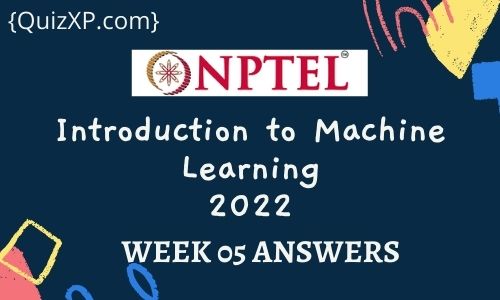Are you looking for the Answers to NPTEL Introduction to Machine Learning Assignment 5 – IIT Madras? This article will help you with the answer to the National Programme on Technology Enhanced Learning (NPTEL) Course “NPTEL Introduction to Machine Learning Assignment 5 “
What is Introduction to Machine Learning?
With the increased availability of data from varied sources there has been increasing attention paid to the various data driven disciplines such as analytics and machine learning. In this course we intend to introduce some of the basic concepts of machine learning from a mathematically well motivated perspective. We will cover the different learning paradigms and some of the more popular algorithms and architectures used in each of these paradigms.
CRITERIA TO GET A CERTIFICATE
Average assignment score = 25% of the average of best 8 assignments out of the total 12 assignments given in the course.
Exam score = 75% of the proctored certification exam score out of 100
Final score = Average assignment score + Exam score
YOU WILL BE ELIGIBLE FOR A CERTIFICATE ONLY IF THE AVERAGE ASSIGNMENT SCORE >=10/25 AND EXAM SCORE >= 30/75. If one of the 2 criteria is not met, you will not get the certificate even if the Final score >= 40/100.
Below you can find the answers for NPTEL Introduction to Machine Learning Assignment 5
| Assignment No. | Answers |
|---|---|
| Introduction to Machine Learning Assignment 1 | Click Here |
| Introduction to Machine Learning Assignment 2 | Click Here |
| Introduction to Machine Learning Assignment 3 | Click Here |
| Introduction to Machine Learning Assignment 4 | Click Here |
| Introduction to Machine Learning Assignment 5 | Click Here |
| Introduction to Machine Learning Assignment 6 | Click Here |
| Introduction to Machine Learning Assignment 7 | Click Here |
| Introduction to Machine Learning Assignment 8 | Click Here |
| Introduction to Machine Learning Assignment 9 | Click Here |
| Introduction to Machine Learning Assignment 10 | Click Here |
NPTEL Introduction to Machine Learning Assignment 5 Answers:-
Q1. The last layer of ANN is linear for _________ and softmax for __________.
Answer:- c
Q2. Consider the following statement and answer True/False with corresponding reason:
The class outputs of a classification problem with a ANN cannot be treated independently
Answer:- b
Q3. Below are two views of a error surface of an ANN (these are 3D plots of the same error function – shown twice with different 2D views for understanding). Pertaining to the plots, what is something you need to keep in mind while training?
Answer:- b
Q4. What happens if we do not use an activation function in an ANN?
Answer:- d
???? Next Week Answers: Assignment 06 ????
Q5. Given below is a simple ANN with 2 inputs X1, X2 ∈ {0, 1} and edge weights -3, +2, +2
Answer:- d
Q6. Consider the following function.
Answer:- d
Q7. Using the notations used in class, evaluate the value of the neural network with a 3-3-1 archi- tecture (2-dimensional input with 1 node for the bias term in both the layers). The parameters are as follows
Answer:- f – 0.8414
Q8. Logistic regression is a special case of ANN with:
Answer:-d
Q9. Which of these are limitations of the backpropagation algorithm?
Answer:- e
Q10. Which of these are true about learning rate (multiple may be correct)?
Answer:- d
For other courses answers:- Visit
For Internship and job updates:- Visit
Disclaimer: We do not claim 100% surety of answers, these answers are based on our sole knowledge, and by posting these answers we are just trying to help students, so we urge do your assignment on your own.
if you have any suggestions then comment below or contact us at [email protected]
If you found this article Interesting and helpful, don’t forget to share it with your friends to get this information.
NPTEL Introduction to Machine Learning Assignment 5 Answers 2022:- All the Answers provided here to help the students as a reference, You must submit your assignment at your own knowledge.


